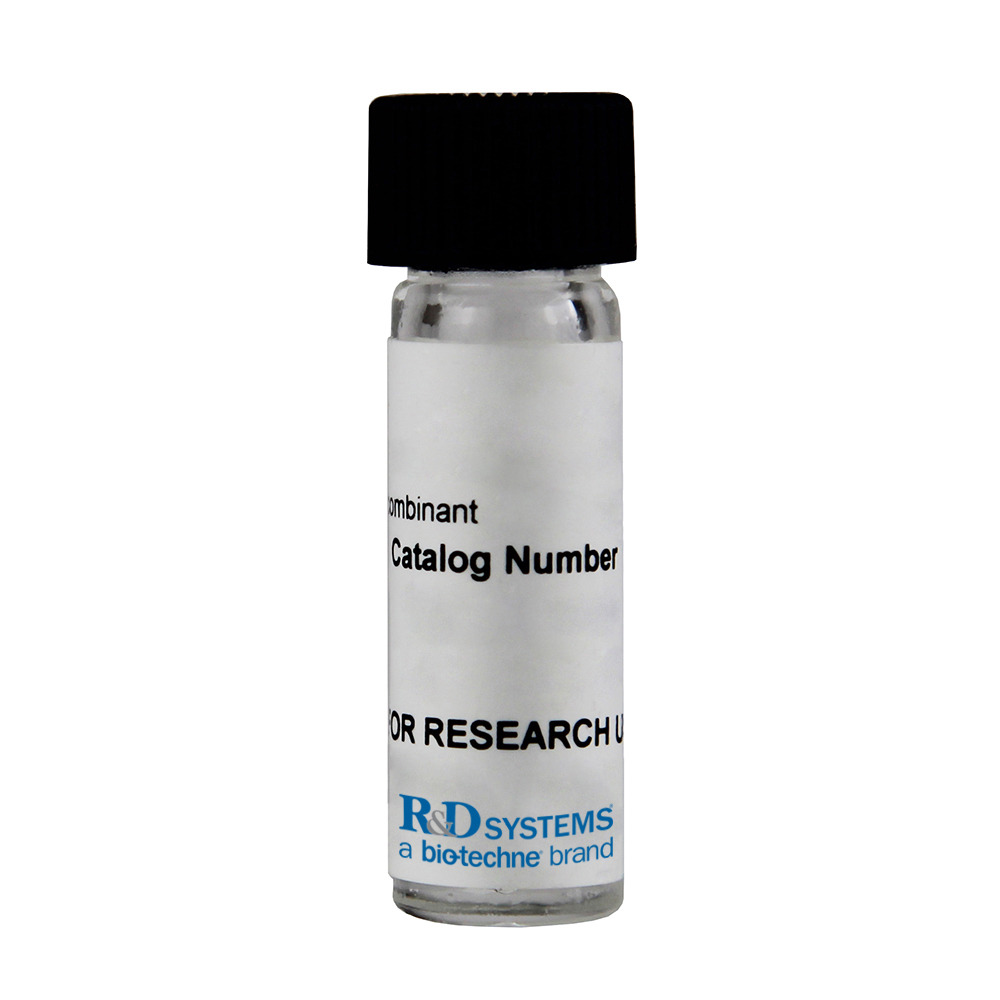

 下载产品说明书
下载产品说明书 下载SDS
下载SDS 用小程序,查商品更便捷
用小程序,查商品更便捷



 收藏
收藏
 对比
对比 咨询
咨询Carrier Free
CF stands for Carrier Free (CF). We typically add Bovine Serum Albumin (BSA) as a carrier protein to our recombinant proteins. Adding a carrier protein enhances protein stability, increases shelf-life, and allows the recombinant protein to be stored at a more dilute concentration. The carrier free version does not contain BSA.
In general, we advise purchasing the recombinant protein with BSA for use in cell or tissue culture, or as an ELISA standard. In contrast, the carrier free protein is recommended for applications, in which the presence of BSA could interfere.
2629-FG/CF
| Formulation | Lyophilized from a 0.2 μm filtered solution in MOPS, Na2SO4, EDTA and DTT. |
| Reconstitution | Reconstitute at 100 μg/mL in sterile PBS. |
| Shipping | The product is shipped at ambient temperature. Upon receipt, store it immediately at the temperature recommended below. |
| Stability & Storage: | Use a manual defrost freezer and avoid repeated freeze-thaw cycles.
|
Recombinant Mouse FGF-23 Protein, CF Summary
Product Specifications
Tyr25-Val251 (Arg179Gln), with a C-terminal 6-His tag
Analysis

Background: FGF-23
Fibroblast growth factor 23 (FGF-23) is a 30 - 32 kDa member of the FGF gene family. Based on its structure, it is further classified as an FGF19 subfamily member. This subfamily includes FGF-19, -21, and -23. Like all other FGF subfamilies, FGF-19 subfamily members contain a 120 amino acid (aa) core FGF domain that exhibits a beta -trefoil structure (1, 2). Unlike other FGF subfamilies, FGF-19 subfamily members exist as highly diffusible molecules that is attributed to poor ECM/heparin sulfate binding (3, 4, 5, 6). The cDNA for mouse FGF-23 predicts a 251 aa polypeptide that contains a 24 aa signal sequence and a 227 aa mature region (7). Mature mouse FGF-23 shows 72% aa identity to human FGF-23 (8). The FGF-19 subfamily shares an unusual receptor configuration. The standard model for FGF signaling requires an FGF:FGFR:heparin sulfate complex. Given FGF-23’s minimal association with heparin, a substitute termed ( alpha -) Klotho has evolved that serves the same function. Although FGF-23 binds to the widely expressed “c” isoforms of FGFR1 and 3 plus FGFR4, Klotho has a restricted distribution that limits FGF-23 activity (10, 11, 12). It should be noted that heparin-dependency has been reported for FGF-19 signaling, and this observation may extend to FGF-23 (13). The FGF-19 subfamily is considered endocrine in nature. All three subfamily members impact some aspect of metabolism and all three are induced by a nuclear receptor heterodimer that includes the retinoid X receptor (14, 15, 16). FGF-23 is considered a phosphatonin; that is, a molecule that reduces circulating plasma phosphate. It is produced by osteocytes and osteoblasts in response to high circulating phosphate levels, elevated parathyroid hormone that induces hypercalcemia, and circulatory volume loading. Upon binding to FGF-23 receptors on renal proximal tubular epithelium, two basic changes are seen. First, the enzyme responsible for generating the active form of vitamin D is suppressed, resulting in decreased levels of bioactive vitamin D. Since vitamin D promotes intestinal phosphate absorption, plasma phosphate declines. Second, the transporters responsible for phosphate resorption on renal epithelium are down regulated, resulting in decreased uptake from urine and again a decline in blood phosphorus (17, 18).
- Itoh, N. and D.M. Ornitz (2004) Trends Genet. 20:563.
- Mohammadi, M. et al. (2005) Cytokine Growth Factor Rev. 16:107.
- Fukumoto, S. (2007) Endocr. J. Sep 14; [Epub ahead of print].
- Huang, X. et al. (2006) Mol. Carcinog. 45:934.
- Goetz, R. et al. (2007) Mol. Cell. Biol. 27:3417.
- Harmer, N.J. et al. (2004) Biochemistry 43:629.
- Yamashita, T. et al. (2000) Biochem. Biophys. Res. Commun. 277:494.
- Shimada, T. et al. (2001) Proc. Natl. Acad. Sci. USA 98:6500.
- Kato, K. et al. (2006) J. Biol. Chem. 281:18370.
- Zhang, X. et al. (2006) J. Biol. Chem. 281:15694.
- Urakawa, I. et al. (2006) Nature 444:770.
- Hurosu, H. et al. (2006) J. Biol. Chem. 281:6120.
- Wu, X. et al. (2007) J. Biol. Chem. 282:29069.
- Moore, D.D. (2007) Science 316:1436.
- Ogawa, Y. et al. (2007) Proc. Natl. Acad. Sci. USA 104:7432.
- Kurosu, H. et al. (2007) J. Biol. Chem. 282:26687.
- Razzaque, M.S. and B. Lanske (2007) J. Endocrinol. 194:1.
- Liu, S. et al. (2007) Curr. Opin. Nephrol. Hypertens. 16:329.









 危险品化学品经营许可证(不带存储) 许可证编号:沪(杨)应急管危经许[2022]202944(QY)
危险品化学品经营许可证(不带存储) 许可证编号:沪(杨)应急管危经许[2022]202944(QY)  营业执照(三证合一)
营业执照(三证合一)